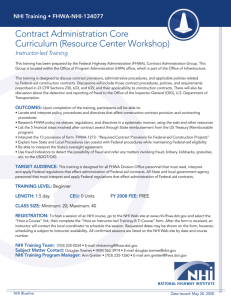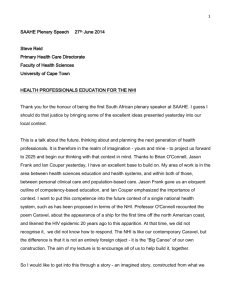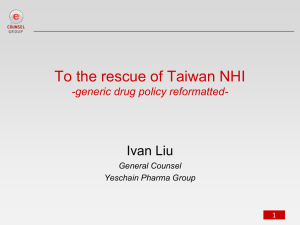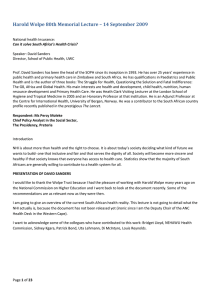17.315 Health Policy Harvey M. Sapolsky THE AMERICAN HEALTH CARE SYSTEM
advertisement
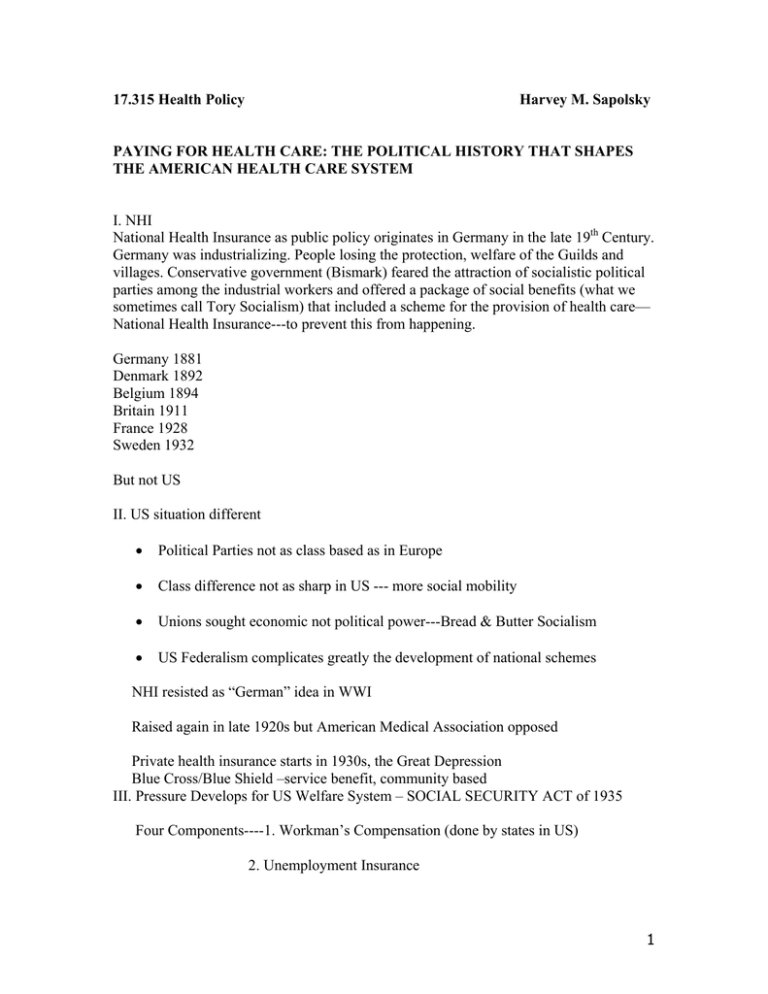
17.315 Health Policy Harvey M. Sapolsky PAYING FOR HEALTH CARE: THE POLITICAL HISTORY THAT SHAPES THE AMERICAN HEALTH CARE SYSTEM I. NHI National Health Insurance as public policy originates in Germany in the late 19th Century. Germany was industrializing. People losing the protection, welfare of the Guilds and villages. Conservative government (Bismark) feared the attraction of socialistic political parties among the industrial workers and offered a package of social benefits (what we sometimes call Tory Socialism) that included a scheme for the provision of health care— National Health Insurance---to prevent this from happening. Germany 1881 Denmark 1892 Belgium 1894 Britain 1911 France 1928 Sweden 1932 But not US II. US situation different • Political Parties not as class based as in Europe • Class difference not as sharp in US --- more social mobility • Unions sought economic not political power---Bread & Butter Socialism • US Federalism complicates greatly the development of national schemes NHI resisted as “German” idea in WWI Raised again in late 1920s but American Medical Association opposed Private health insurance starts in 1930s, the Great Depression Blue Cross/Blue Shield –service benefit, community based III. Pressure Develops for US Welfare System – SOCIAL SECURITY ACT of 1935 Four Components----1. Workman’s Compensation (done by states in US) 2. Unemployment Insurance 1 3. Retirement Benefits 4. National Health Insurance Democrats under FDR enact SOCIAL SECURITY ACT in 1935 that gives American 2. Unemployment Insurance and 3. Retirement Benefits. But provision for health insurance dropped because of MD opposition. Ever since the Democrat Party Quest to complete the package of reform—the Welfare State in America. SS ACT of 1935 did however effect very much future of American health system Had component that offered grants to states for Maternal Care, Child Care, Disabled Children, Public Health thus setting up categories of deserving poor and making the states governments very much part of system. The DECENTRALIZATION stays with the system. IV. Why we have a private based insurance system. • WWII government froze wages to control costs, but allowed employers to compete for workers via non-wage benefits. Some gave health benefits. • Treasury regulations allowed benefits to be to be excluded from income tax. Today that is $100 billion plus incentive for private, employer provided health insurance ---hugely important. • Supreme Court ruled in 1948 that labor unions could bargain for health benefits. Big unions (autos, steel, rubber) lead way in spreading and expanding work related health insurance. Unions push for first dollar coverage. Management sees benefit as way to build employee loyality---workers lose benefit if leave job. • Blue Cross/Blue Shield had community rating rate system---everyone in one pool and pay experience of community pool. Private insurance companies promote EXPERIENCE RATING---each employer own pool. This means insurance companies can seek out (SKIM) healthier work forces and offer lower rates. For example, Universities have young, health (highly educated) pool. They can lower rate and leave sicker employees (say trucking companies) to stay in community rated pool. It is like private schools vs public schools. Most professors live in suburbs and/or send their children to private schools (MIT helps them through higher ed benefit so don’t have to save as much for college ed). “Smarter” kids then out of public system. The harder to educate, more costly students left for inner city public schools. Same for community rating or private pay. Experience rating makes for cheaper insurance, deeper coverage for private insurance. 2 • Blue Cross/Blue Shield set up initially by local hospital associations and medical societies respectively to help their members get paid in depression. Their presence which was quite large helped avoid NHI also by giving a non-profit, union oriented, community based system alternative. Private insurance (Blues and for profit commercial insurers) spread private, employment dependent health insurance widely in US after WWII. Government aided as described above. RESULT IS THAT US HAS PRIVATE SYSTEM ---TOO MANY PEOPLE HAVE PRIVATE INSURANCE FOR NHI TO BE EASILY ADOPTED. THEY THINK THAT THEY MAY HAVE TO GIVE UP SOMETHING (OR CAN BE PERSAUDED THAT THAT IS THE CASE). DOCTORS AND HOSPITAL LIKE SYSTEM AS IT DIVIDES BUYERS OF HEALTH CARE SERVICES> THEY DO NOT FACE ONE STRONG BUYER (AS THEY WOULD WITH NHI). V. Many attempts to have NHI and NIH. President Truman proposed it but AMA too powerful at time. Bill failed in 1950. Government does help hospital construction after WWII and provides for health care of Veterans (veterans marched for benefits in Depression). Separate government system for Veterans. Also government has hospitals and clinics for Indians, prisoner, and the military plus public health system that guarantees care for Merchant Marine. If Democrat Party pushes for NHI and government provision of care (above), Republican Party pushes for research (as one Republican congressman called research---the best health insurance of them all). Now politicians compete to give money the National Institutes of Health NIH (not NHI). Billions for research LEADS TO A VERY TECHNOLOGICALLY INTENSE HEALTH CARE SYSTEM. President Johnson, another Democrat, wanted to complete the NHI quest—came close in 1967 with passage of MEDICARE AND MEDICAID PROGRAM. VI Medicare and Medicaid 1967 Medicare Part A Hospital Coverage Mandatory Tax financed Democrats wanted Part A 3 Part B Physician Coverage Option (voluntary) Premium deduction copayment Republicans want Part B Medicaid Coverage for the Poor Shared with states Blind,Disabled,Nursing Home Women and Infants (WIC) AMA advocated Medicaid Congressman Wilber Mills put it all together End Stage Renal Disease Coverage added 1972 Huge consequences: • Tremendous inflation---M&M took away elder who had to self pay in private system. They had most of expenses remember. Were the brake on the system. Medicare pays for them. Thus inflation. • Technology--- no controls imposed on demand –fee for service; full coverage for Medicare. Big impetus for more technology. Old could now pay for all that could be done. Makes cost the focus of any expansion. Medicare (and Medicaid with nursing home coverage) force government to keep feeding system. Politically impossible to control which means only thing is to block new coverage proposals. • VI SYSTEM SUMMARY > Employment linked, private insurance for most of population > Most people (Middle Class) have good coverage –Fear change > Deep insurance > Government pays for costly patients—elderly, disabled. 4

